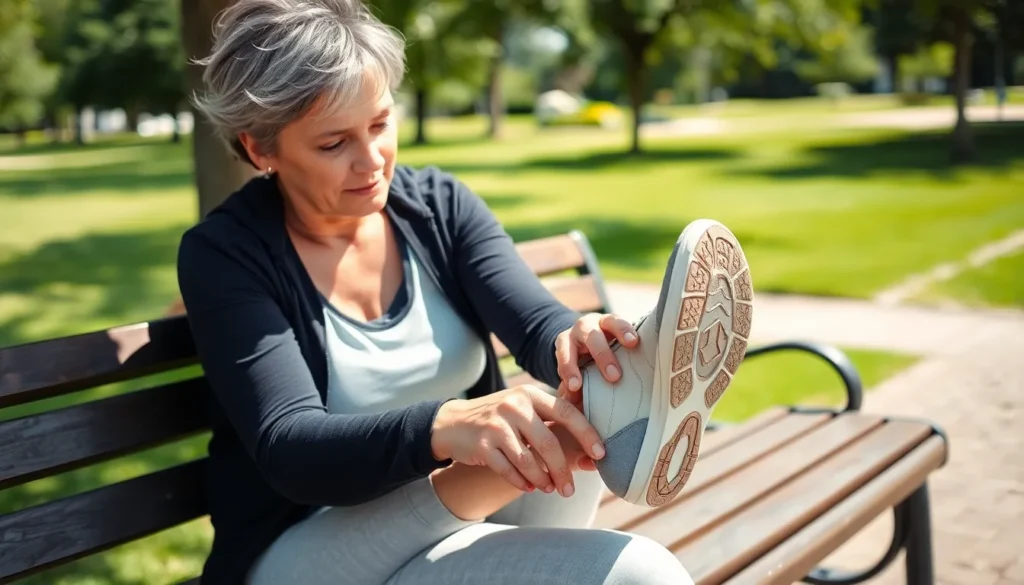Table of Contents
TogglePavatalgia disease might sound like a fancy dish at a gourmet restaurant, but trust us, nobody wants to order that off the menu. This pesky condition can leave anyone feeling like they’ve just run a marathon in flip-flops. But don’t worry; preventing it doesn’t require a PhD in medical jargon or a secret handshake.
Understanding Pavatalgia Disease
Pavatalgia disease primarily affects the feet and causes significant discomfort. Symptoms often include sharp pain, swelling, and a burning sensation in the lower extremities. Individuals may experience difficulty walking or standing for extended periods. Understanding the underlying causes can assist in effective prevention.
Genetics plays a vital role in the predisposition to Pavatalgia. Some individuals inherit conditions that make them more susceptible to foot pain and discomfort. Age also influences risk, with older adults experiencing changes in foot structure and function. Footwear choice contributes significantly to the onset of Pavatalgia. Wearing shoes that lack proper support or cushioning can exacerbate symptoms.
Lifestyle factors matter as well. Staying active helps maintain foot health, while excessive weight can increase pressure on the feet. Activities that involve repetitive stress, such as running or dancing, may lead to discomfort if not managed properly. Regular stretching can improve flexibility and reduce tension in the feet.
Preventative measures are straightforward. Choosing appropriate footwear ensures adequate support, cushioning, and stability. Regular foot care, including proper hygiene and moisturizing, can prevent dryness and cracking. Engaging in low-impact exercises strengthens the muscles that support the foot. Additionally, incorporating rest periods into physical activities helps alleviate strain.
Understanding Pavatalgia enables individuals to take proactive steps in prevention. Awareness of risk factors, combined with appropriate footwear and exercise, fosters foot health and reduces discomfort.
Symptoms of Pavatalgia Disease

Pavatalgia disease manifests through various symptoms, significantly impacting daily activities.
Recognizing Early Signs
Early signs of Pavatalgia disease often include sudden foot pain that feels sharp, indicating discomfort when standing or walking. Additionally, swelling around the arches can occur, making it hard to find comfortable shoes. Individuals may notice a burning sensation that intensifies after prolonged periods of activity. Changes in foot sensitivity or an unusual feeling when walking also signify issues. Monitoring these symptoms closely allows for swift adjustments to lifestyle or footwear choices, ultimately reducing long-term complications.
When to See a Doctor
Seeing a doctor becomes necessary when symptoms worsen or persist beyond a few days. If sharp pain hinders daily activities, professional assessment is crucial. Increased swelling or redness often indicates underlying problems requiring medical attention. Individuals should consider consulting a healthcare professional if they experience numbness or tingling in their feet as these sensations may signal nerve issues. Timely intervention can facilitate proper diagnosis and treatment options, promoting better foot health.
Prevention Strategies
Preventing Pavatalgia involves simple yet effective strategies targeting foot health. Implementing lifestyle changes, dietary considerations, and exercise modifications contributes significantly to reducing discomfort.
Lifestyle Changes
Choosing supportive footwear plays a crucial role in prevention. It’s essential to select shoes that provide adequate arch support and cushioning. Regular foot care routines, including proper hygiene and moisturizing, also help maintain skin integrity. Maintaining a healthy weight reduces pressure on the feet, decreasing the likelihood of pain. Additionally, taking breaks during long periods of standing or walking ensures feet receive necessary rest.
Dietary Considerations
A balanced diet directly influences overall health, including foot health. Incorporating anti-inflammatory foods can reduce swelling and discomfort. Omega-3 fatty acids, found in fish and walnuts, help lower inflammation. Maintaining hydration promotes optimal circulation, which is vital for foot health. Consuming adequate calcium and vitamin D supports bone strength, contributing to stronger foot structures.
Exercise and Physical Activity
Engaging in low-impact exercises protects the feet while fostering overall fitness. Activities like swimming and cycling provide cardiovascular benefits without excessive strain. Stretching exercises targeting the feet and calves improve flexibility and reduce tension. Practicing balance and strengthening exercises enhances stability and support for the feet. Regularly scheduled rest days prevent overexertion and aid in recovery.
Seeking Professional Help
Consulting with a healthcare professional can significantly improve outcomes related to Pavatalgia. Specialists such as podiatrists focus on foot health and can provide tailored recommendations. They assess symptoms and identify underlying causes, ensuring an effective treatment plan. Patients experiencing persistent pain or swelling benefit from expert evaluation.
Consulting a Specialist
Consulting a specialist becomes essential when dealing with persistent symptoms of Pavatalgia. Podiatrists specialize in foot conditions and understand how to navigate various treatment options. They can perform comprehensive examinations and recommend appropriate diagnostic tests. After diagnosing the condition, specialists provide individualized treatment plans that may include physical therapy or orthotic devices. Seeking help sooner rather than later prevents the progression of the condition and helps patients regain mobility.
Importance of Regular Check-Ups
Regular check-ups should form a key part of proactive foot health management. Scheduling appointments with healthcare professionals every six to twelve months ensures any issues receive timely attention. Experts can track changes in foot health and adjust preventive strategies accordingly. During these visits, individuals receive guidance on footwear choices and exercise routines that benefit overall foot function. Maintaining regular consultations promotes ongoing awareness and incorporates preventative measures into daily habits.
Preventing Pavatalgia disease is achievable with some straightforward lifestyle adjustments. By choosing the right footwear and practicing regular foot care, individuals can significantly reduce their risk of discomfort. Staying active with low-impact exercises and maintaining a healthy weight further supports foot health.
It’s essential to listen to the body’s signals and monitor any emerging symptoms. Early intervention can make a substantial difference in managing foot health. Consulting with healthcare professionals when needed ensures that individuals receive personalized guidance and effective treatment options. By prioritizing foot care, they can enjoy a more comfortable and active life.




